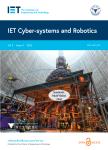A trajectory summarisation gener
作者机构:School of Electrical and Control EngineeringShaanxi University of Science and TechnologyXi'anChina School of Artificial IntelligenceHangzhou Dianzi UniversityHangzhouChina School of Mechanical EngineeringHangzhou Dianzi UniversityHangzhouChina
出 版 物:《IET Cyber-Systems and Robotics》 (智能系统与机器人(英文))
年 卷 期:2023年第5卷第1期
页 面:154-164页
学科分类:08[工学] 081101[工学-控制理论与控制工程] 0811[工学-控制科学与工程] 081102[工学-检测技术与自动化装置]
基 金:supported in part by the NSFC(No.61771177,U1934211) Shaanxi Province Key Research and Development Program(No.2021GY-087)
主 题:behaviour analysis behaviour semantics natural language processing semantic trajectory trajectory summarisation
摘 要:The semantic representation of the trajectory is conducive to enrich the content oftrajectory data mining. A trajectory summarisation generation method based on themobile robot behaviour analysis was proposed to realize the abstract expression andsemantic representation of the spatio-temporal motion features of the robot and itsenvironmental interaction state. First, the behavioural semantic modelling and representationof the mobile robot are completed by modelling the sub-trajectory andcalculating the topological behaviour (TOP). Second, Chinese word segmentation andsemantic slot filling methods are used to combine with hierarchical clustering to performbasic word extraction and classification for describing trajectory sentences. Then, thedescription language frame is extracted based on the TOP, and the final trajectorysummarisation is generated. The result shows that the proposed method can semanticallyrepresent robot behaviours with different motion features and topological features,extract two verb-frameworks for describing the sentences according to their topologicalfeatures, and dynamically adjust the syntactic structure for the different topological behavioursbetween the target and the environment. The proposed method can generatesemantic information of relatively high quality for spatio-temporal data and help tounderstand the higher-order semantics of moving robot behaviour.



